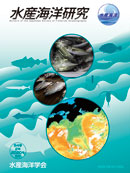The deepsea smelt Glossanodon semifasciatus is one of the most important commercial fish for the offshore demersal trawl fisheries around Japan. Although growth is an influential factor for survival during the early life stage and recruitment to the fishery resource, little is known about growth and survival in deepsea smelt larvae and juveniles. Larvae and juveniles of deepsea smelt were collected with a small otter-trawl net in Tosa Bay, southwestern Japan, monthly from April 2008 to March 2010. From the monthly variations of the standard length (SL) histograms, small specimens (SL<40 mm) were recruited from February to July and were continuously sampled up to 100 mm SL. In each cohort, increments in the number of otolith rings between sampling campaigns corresponded approximately with the number of days of the sampling interval, indicating the daily formation of otolith rings. The date of first ring formation (DFRF) was distributed continuously from February to July, which is considered the main spawning season of deepsea smelt in Tosa Bay. This finding does not correspond with previous studies that found two spawning seasons (spring and autumn) in the deepsea smelt sub-population of the Sea of Japan. Monthly distributions of DFRF indicated two groups of cohorts in spring and summer in 2008, whereas in 2009 one group of cohorts was found only in spring. To characterize growth patterns, mean increment widths at 5-day intervals from the 1st to the 56th otolith daily rings were calculated in each group in 2008 and 2009. Narrower increment widths were found in the spring group of 2008 and 2009, within which those sampled later (i.e., long-term survivors) tended to have wider increment widths than those sampled earlier (i.e., short-term survivors). However, wider increment widths were found in the summer group of 2008, within which those sampled earlier had wider increment widths than those sampled later. The results suggest that growth-selective survival is perceptible in deepsea smelt larvae only under unfavorable growth conditions in Tosa Bay.
View full abstract
